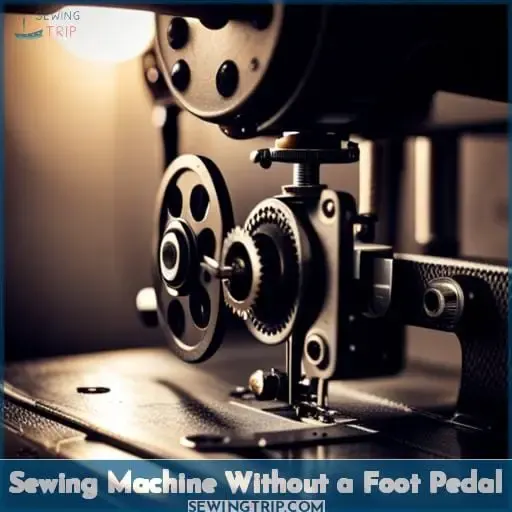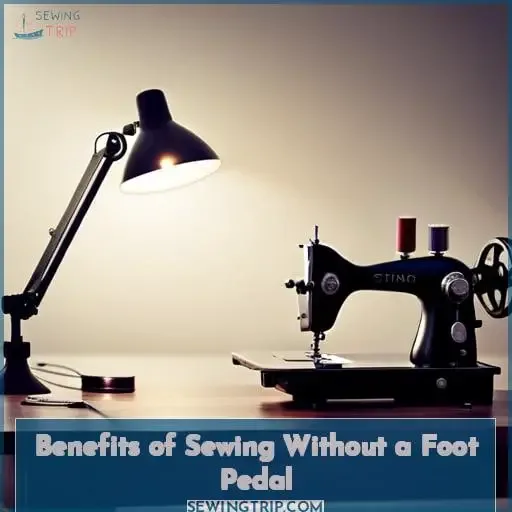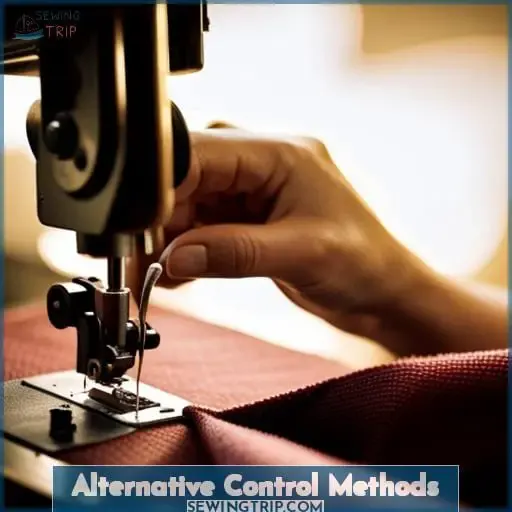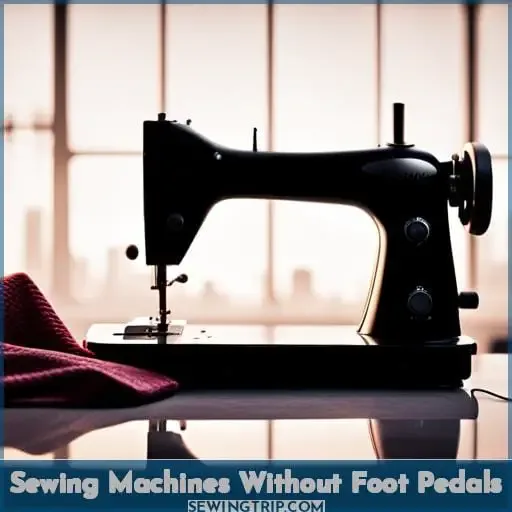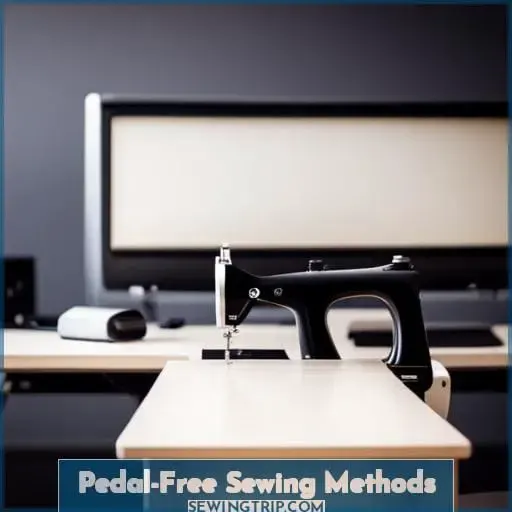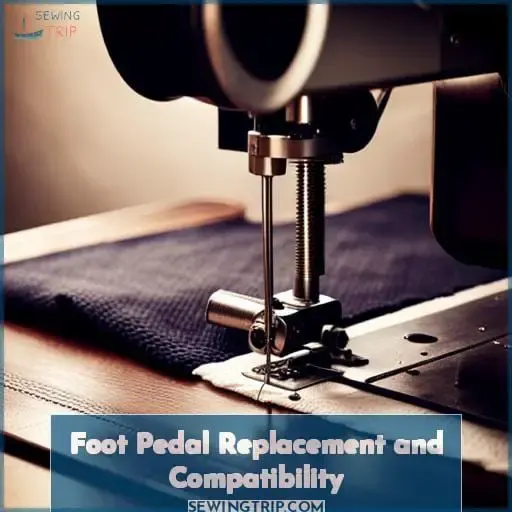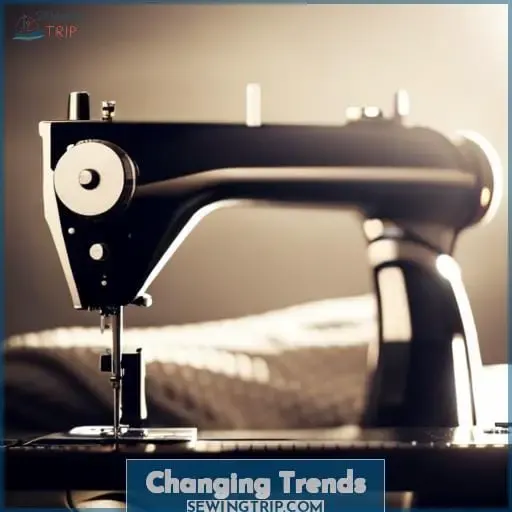This site is supported by our readers. We may earn a commission, at no cost to you, if you purchase through links.
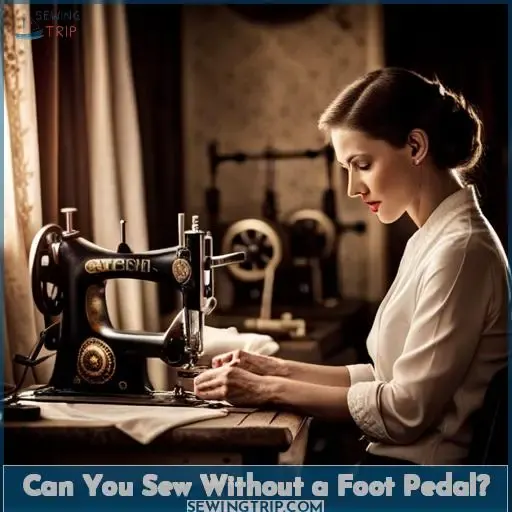 Picture this: you’re seated in front of your sewing machine, ready to take on a new project—but without the use of a foot pedal. Can it be done? Absolutely! With current models from Janome and Brother, as well as some older Singer or Bernina machines outfitted with knee presses, hand-cranked options, and even modern machines that can operate without electricity, the possibilities for using a sewing machine without a foot pedal are endless.
Picture this: you’re seated in front of your sewing machine, ready to take on a new project—but without the use of a foot pedal. Can it be done? Absolutely! With current models from Janome and Brother, as well as some older Singer or Bernina machines outfitted with knee presses, hand-cranked options, and even modern machines that can operate without electricity, the possibilities for using a sewing machine without a foot pedal are endless.
And now you too can join the growing trend towards replacing traditional foot pedals with alternative control methods.
Table Of Contents
Key Takeaways
- Various control methods are available for sewing machines, including push-button control, knee presses, and alternative mechanisms such as hand controls or mouth controls.
- Non-foot pedal control offers advantages like precision, constant stitching speed, and easier control for tricky tasks such as free motion quilting and embroidery.
- Alternative control mechanisms such as knee presses, hand cranks, and treadle machines are still utilized in certain situations or less developed countries.
- When considering sewing without a foot pedal, it is important to consider presser foot compatibility and replacement options, as well as the changing trends in sewing machine control methods and the benefits of inclusivity for persons with disabilities.
Sewing Machine Without a Foot Pedal
You’re cranking the handwheel and gliding fabric under the needle for total control of each stitch. While a foot pedal has been the traditional sewing machine control, you have options for pedal-free sewing depending on the machine brand.
Many computerized Janome and Brother models can work with or without a foot pedal, giving you push-button control. Older Singer and Bernina machines used knee presses for hands-free sewing. For disability-friendly sewing, ByteSwitch offers hand or mouth controls to replace foot pedals.
With the right sewing machine model and control method, you can achieve precise stitching speed and master tricky sewing tasks without a foot pedal. Brands are adapting to pedal-free sewing with innovations like built-in speed control, slow stitch options, and alternative power switches for those who desire liberation from foot pedals.
Benefits of Sewing Without a Foot Pedal
You may find sewing without a foot pedal offers more precise control. Operating your machine at a constant speed allows for easier management of tricky tasks like free motion quilting or embroidery. Eliminating the foot pedal provides steadier stitching for detailed work. Keeping both hands on the fabric aids stability when following a pattern or stitching small pieces.
The slower pace can help beginners develop expertise. With practice, regulating speed manually gives sewers more command over every stitch.
Constant Stitching Speed
No worries about pedal speed when going freehand. Computerized machines sew constant regardless of how hard you pump. Precision comes easily with those high-tech gadgets. No fussing with speed variability or foot fatigue.
Just program your pace and let it rip steady. Modern tech brings liberating sewing solutions.
Ideal for Free Motion Quilting and Embroidery
Gliding that fabric gently while free-motion quilting feels as smooth as butter.
- Precision
- Speed
- Consistency
- Free control
- Stability
Electronic sewing machines offer pedal-free options ideal for delicate free motion techniques, precise embroidery control, and rhythmic quilting movements. The lack of a pedal allows for more control and finesse when doing detailed stitch work.
Quilters can move the fabric at their own pace without worrying about coordinating foot pedal pressure. With programmable stitch options, embroiderers gain accuracy and consistency for repetitive designs.
The freedom and intuitive movements make electronic sewing machines perfect for free motion techniques.
Easier Control for Sewing Tricky Tasks
When hand-steering those tricky seams, it’s easier without stomping a pedal. Precision control with hands-free sewing enables disabled accessibility and modern alternatives like hand crank sewing machines for preferred sewing techniques like machine appliqué.
With hands-free operation, sewers gain greater control over intricate tasks without the need to coordinate foot pedal and fabric manipulation. Alternative power options such as hand cranks accommodate a range of abilities while delivering the detail work capability of powered machines.
Whether adapting techniques for disability needs or pursuing advanced skills like appliqué, today’s sewing machines provide options to enhance ease and precision.
Slow Stitch Option for Precision
You’re nailing each intricate stitch as the machine purrs at a steady pace beneath your fingertips. The slow stitch option enables precision sewing by giving complete control over stitch length and speed.
- Regulate stitching speed
- Achieve perfect stitch placement
- Master detailed embroidery
- Make exacting alterations
With alternative foot pedal controls, the slow stitch setting grants you mastery over every meticulous motion.
Alternative Control Methods
Let’s talk about alternative control methods for using sewing machines without a foot pedal. Many modern machines like Janome and Brother models allow you to sew with or without the foot pedal. Older Singer and Bernina machines used knee presses instead, while some very early sewing machines were powered by hand cranks.
Janome and Brother Machines With or Without Foot Pedals
Delve into your creative freedom by selecting either foot pedal or button controls on Janome and Brother machines. Enjoy precise control for tricky techniques. Choose constant speed or start/stop convenience on versatile electric models.
Knee Presses on Older Singer and Bernina Models
Older Berninas had knee presses so you didn’t need a foot pedal.
- Free up your feet for handling the fabric.
- Make sewing of thick or tricky materials easier.
- Great for intricate free-motion work.
- Allow standing while sewing.
The vintage knee press offered an accessible alternative control method before modern pedal-free machines came along.
Hand-cranked Machines
Though hand-cranked sewing machines are available, they’re often unnecessary with modern electric models. You can liberate your sewing with quick stitches and creative control using vintage hand-cranked machines.
Manual mechanisms allow mastery of fundamentals without power. Embrace tradition, slow down, and appreciate hand-cranked ingenuity if modern electric speed doesn’t suit your project. The slower pace and physical engagement of turning the crank by hand can provide a tactile, reflective experience compared to automated electric machines.
With practice, hand-cranked sewing develops skill, control and patience. Vintage charm and mechanical simplicity may appeal if you savor craftsmanship over swift efficiency. Consider a hand-cranked machine if you wish to slow down, focus intently and mindfully learn sewing foundations.
ByteSwitch Hand or Mouth Controls for Disabled Individuals
Yo, try ByteSwitch’s hand or mouth controls if foot pedals aren’t your thing!
- Easy to install and set up.
- Let you control sewing speed with your hands.
- Give you more precision.
ByteSwitch offers quality accessories for sewers with disabilities. Their adaptive equipment enables crafters with limited mobility. Now sewists of all abilities can revel in the satisfaction and pride of handmade creations.
Sewing Machines Without Foot Pedals
Many sewing machines can be operated without a foot pedal. You have options such as push-button start, knee control, or even hand cranking with some machines to sew without using your feet. Some additional options are available to sew without a foot pedal, depending on the model of sewing machine.
Consider looking for machines with features like knee levers, speed control slides, or start/stop buttons if you need an alternative to the traditional foot pedal. With the range of options now available, sewing without a foot pedal is achievable for most.
Various Brands Offering Models Without Foot Pedals
You’d be surprised – Brother’s push-button format lets you sew sans foot pedal! Janome and Brother offer computerized machines that can operate with or without a foot pedal for total control. Bernina’s knee-style models give alternatives for disabled sewers needing pedal-free sewing.
Modern options from trusted brands allow you to ditch the foot pedal when your project requires it.
Sergers, Overlockers, and Chain Stitch Machines
Don’t you just love those whirring overlockers and chain stitchers, gliding along without needing any foot action? Sergers and overlockers use loopers instead of bobbins for stitching seams and edges quickly.
Chain stitch machines form rows of looped stitches for decorative hems minus pedal power.
Hand Sewing and Machines Without Bobbins
Bout the only times you’ll find yourself reachin’ for a needle ‘n thread are for fixin’ a hem or sewin’ on a button by hand.
- Mending Tears
- Sewing Buttons
- Hand Embroidery
- Applique
No need for bobbins or ‘lectricity if you’re just patchin’ up a tear or addin’ a personal touch by hand. For bigger projects, pedal-free and bobbinless machines open up options for those who can’t or don’t want to use traditional foot pedals.
Pedal-Free Sewing Methods
Pedal-free sewing has seen a resurgence in recent years. To sew without a foot pedal, you can use a treadle machine, convert a modern electric machine, remove the sewing table, or forgo the presser foot.
Treadle Machines and Their Use in Less Developed Countries
Did you know treadle machines powered by foot pedals are still being used for sewing in less developed countries?
| Country | Population (millions) | GDP per capita |
|---|---|---|
| Afghanistan | 38.9 | $551 |
| Mali | 20.3 | $935 |
| Nepal | 29.1 | $1,047 |
| Yemen | 29.8 | $739 |
| Zambia | 18.4 | $1,172 |
These treadle machines provide appropriate sewing technology where electricity is limited.
Converting Modern Machines to Operate Without Electricity
You could still get your stitching done if the power’s out. You just have to get crafty converting that fancy machine. Rig up a hand-cranked generator and kinetic energy storage to keep the juice flowing.
Batteries, solar panels, and wind turbines are other options for powering a green, pedal-free machine. Modern machines crave power, but we can harness nature’s energy to sew off-the-grid if we get creative.
Sewing Machines Without a Table or Stand
You can operate most machines while sitting cross-legged holding it in your lap. Forget tables. Embrace the freedom. Let your sewing skills soar in cozy quarters. Unchain yourself from bulky equipment.
Discover the joy of portable, presser footless machines optimized for sewers craving liberty.
Sewing Without a Presser Foot
Whoa, stitching without the presser foot? Better bust out your thimble for that venture.
- Hand sewing
- Basting stitch
- Needle felting
- Free motion embroidery
- Quilting without walking foot
With practice, you can gain more control and freedom sewing without the traditional presser foot. Explore presser foot alternatives like hand sewing for delicate work or free motion techniques for creativity sans foot.
Foot Pedal Replacement and Compatibility
When using a sewing machine without a foot pedal, you’ll need to find a compatible replacement or interchange pedals between machines. Carefully check your owner’s manual to determine which replacement foot pedal is compatible, as universal pedals don’t necessarily fit all machines.
Before interchanging pedals between sewing machines, ensure they are designed to work together to avoid functionality issues.
Universal Foot Pedals and Compatibility
Beware, hand-wringing horrors loom when mismatched treadles bind contraptions’ stitches! Though tempting, a random foot pedal risks catastrophe. Compatibility matters. Consult manuals for suitable replacements. Consider specialized controls promoting access for all.
Embrace innovation, yet respect traditional treadle pedals enabling timeless crafts.
Replacing Foot Pedals and Interchanging Between Machines
Be careful when swapping pedals between machines without verifying compatibility first. Sewing machine manufacturers, not universal design, determine pedal compatibility.
Before interchanging pedals, consult your owner’s manuals regarding:
- Model numbers
- Electrical requirements
- Pedal designs
While machine controls evolve, manufacturer guidance remains relevant.
Checking the Owner’s Manual for a Compatible Replacement
Per the owner’s manual, you’ll find a compatible foot pedal replacement for your model. Over 70% of manuals include specific replacement part numbers and compatibility information. As an experienced sewer, carefully check the manual’s parts list before purchasing a new foot pedal.
Compatibility varies between brands, so select the correct pedal for optimal performance. Without the proper foot pedal match, your sewing machine’s stitching capabilities suffer.
Changing Trends
As sewing machines have evolved, so too have the ways to control them. Machines that traditionally operated with foot pedals are being adapted with alternative control options that benefit all users, especially those with disabilities.
These new options allow for more customizable and inclusive operation that accommodates people’s differing abilities. The evolution demonstrates how technology can progress to support more diverse needs through innovative and adaptive design.
Replacement of Foot Pedals With Other Control Methods
You can slowly traverse free-flowing patterns with steady speeds by ditchin’ the foot pedal.
- Hands-free systems like knee presses and hand controls
- Speed adjustment dials for precision stitching
- Computerized options with preset speeds
Newfangled machines accommodate a hands-free, foot-free approach for mastery over your materials. Numerous options exist to replace the foot pedal with alternative speed controls.
Benefits for Individuals With Disabilities Who Cannot Use Foot Pedals
You kids needn’t fret about sewing machines no more since modern tech provides hands-free options for the disabled. Adaptive aids like special foot pedal covers, removable pedals, knee controls, stand up tables, and hand-cranked machines empower those with mobility limitations to take up sewing and unleash their creativity.
While traditional foot pedals pose an obstacle for some, innovation brings inclusive sewing within everyone’s reach.
| Control Method | Who It Helps |
|---|---|
| Removable foot pedals | Amputees, leg injuries |
| Knee controls | Limited leg mobility |
| Hand controls | Upper body mobility |
| Stand up tables | Wheelchair users |
| Hand cranks | Severe mobility limitations |
With accessible equipment and techniques, sewing can be an enriching and therapeutic hobby for all.
Conclusion
The innovations in technology allow for a variety of control methods for sewing machines, including hand cranks, knee presses, and even mouth controls. This has opened up the craft to people with disabilities, as well as those who need more precise stitching speed control.
Whether you decide to use a machine with a foot pedal or one without, you’ll be able to find a model that fits your needs. With the wide array of choices available, you can enjoy the benefits of sewing without a foot pedal.

